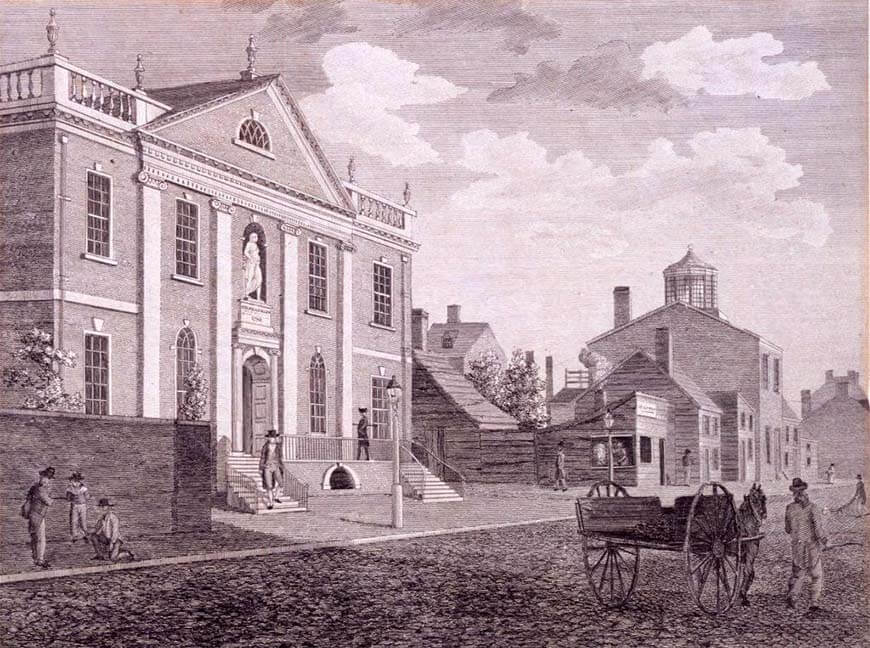Over two public lectures in Philadelphia in late May 1765, a 29-year-old European-educated ex-army surgeon delivered a rousing call to arms about the importance of medical education in America.
Later published as ‘A Discourse Upon the Institution of Medical Schools in America,’ Dr. John Morgan’s speech, along with continuing discussions with the College of Philadelphia, were the final steps in a process about to make history.
America’s first – and oldest – medical school was about to be created.
Now the Perelman School of Medicine at the University of Pennsylvania, ‘Penn Med’ can directly trace its lineage right back past the signing of the Declaration of Independence to the figurative ‘Big Bang’ of North American medical education.
Though it is hard to pinpoint the exact dates of foundation, the first university medical schools began popping up in Europe between the 12th and 13th centuries. Bologna (Italy), Montpellier (France), and London and Oxford (England) are recognized as amongst the first four, with Montpellier 1 University’s Faculty of Medicine, opened in 1181, credited as likely the oldest still in operation.
Before 1765, no such institution existed on the other side of the Atlantic. According to PBS, there were around 3500 practicing doctors in pre-Revolutionary War America, though “most had more in common with a medieval barber than a modern M.D.”
Emetics, diuretics, and leeches were commonly used by doctors to attempt to cure ailments, while opiates and quinine were used to reduce pain and malaria; then a common problem.
Though doctors did hold informal lectures on medical practices during the 1750s and 1760s (including Philadelphia’s Dr. William Shippen Jr), it is thought that the concept of an American medical school was first discussed by Dr. Morgan and Dr. Shippen Jr when the two Pennsylvanians were studying medicine at Scotland’s University of Edinburgh in the early 1760s.
Much to his colleague’s chagrin, Dr. Morgan, who had served as a British surgeon during the Seven Years War, presented the idea to the College of Philadelphia alone in early 1765. After receiving the green light to proceed, Dr. Morgan was made the first medical professor in America on May 3, 1765, and recruited Dr. Shippen Jr and Dr. Adam Kuhn as fellow faculty soon after.
Most had more in common with a medieval barber than a modern M.D.
That fall, studies began. Dr. Morgan gave lectures on the ‘theory and practice of physick’, while Dr. Shippen Jr taught anatomy, surgery, and midwifery. Dr. Kuhn taught chemistry, botany, and ‘materia medica’ (basic pharmacology).
By the end of the 1760s, admired Philadelphia civic leader Dr. Benjamin Rush would join the school’s staff. An early abolitionist and soon-to-be signer of the Declaration of Independence, Rush was recognized by the American Psychiatric Association in 1965 as the “father of American psychiatry.”
Modeled on the University of Edinburgh program, bachelors and doctorates in medicine were offered to students for their studies. To receive a bachelors, students were required to attend lectures and clinical lessons, attend practice at the Pennsylvania Hospital for a year, serve an apprenticeship under a noted local doctor, prove their knowledge of Latin and mathematics as well as pass a public exam.
To attain a doctorate, the aspiring M.D. had to be at least 24, have held a bachelors for three years or more, and write and publicly defend a thesis that was published at their own expense.
By 1767, the school had 20 all-male students who paid five guineas each to study at Philadelphia’s long-since-demolished Surgeon’s Hall, located at Fifth and Walnut. The following year, Maryland’s John Archer became America’s first official medical graduate, later serving as a U.S. Congressman between 1801 and 1807 (it wasn’t until 1918 that the first two women – Dr. Gladys Girardeau and Dr. Alberta Peltz – would become doctorate graduates from Penn Med).
Following Philadelphia’s example, similar institutions began to sprout up with New York’s King’s College (later Columbia University) starting their own medical school in 1767, followed by Harvard Medical School in 1782.
The American Revolution shook things up, however. In 1775, Dr. Morgan was appointed the chief physician of George Washington’s Continental Army but struggled with limited supplies, a smallpox outbreak, and a lack of trust from politicians and army officers.
Dr. Shippen took over from his fellow professor before Dr. Morgan charged him with fraud. Though the pair are credited today as their medical school’s co-founders, only Dr. Shippen Jr returned to their history-making institution after the war, which temporarily had its charter revoked in the mid-1780s for suspected pro-British sympathies amongst its staff.
By 1789, the same year Dr. Morgan died, it was restored. In 1791, the school was bought under the umbrella of the new University of Pennsylvania.
More than 250 years later, the school now has over 2600 faculty members and 766 medical students and is regularly ranked among the best medical research schools in the United States.
“Perhaps this Medical Institution, the first of its kind in America, though small in its beginning, may receive a constant increase in strength and annually exert new vigor,” Dr. Morgan wrote, and told Philadelphia crowds, in 1765.
“It may collect a number of young persons of more than ordinary abilities, and so improve their knowledge as to spread its reputation to distant parts.
“By sending these abroad duly qualified, or by exciting an emulation amongst men of parts and literature, it may give birth to other useful institutions of a similar nature, or occasional rise, by its example, to numerous societies of different kinds calculated to spread the light of knowledge through the whole American continent wherever inhabited.”



